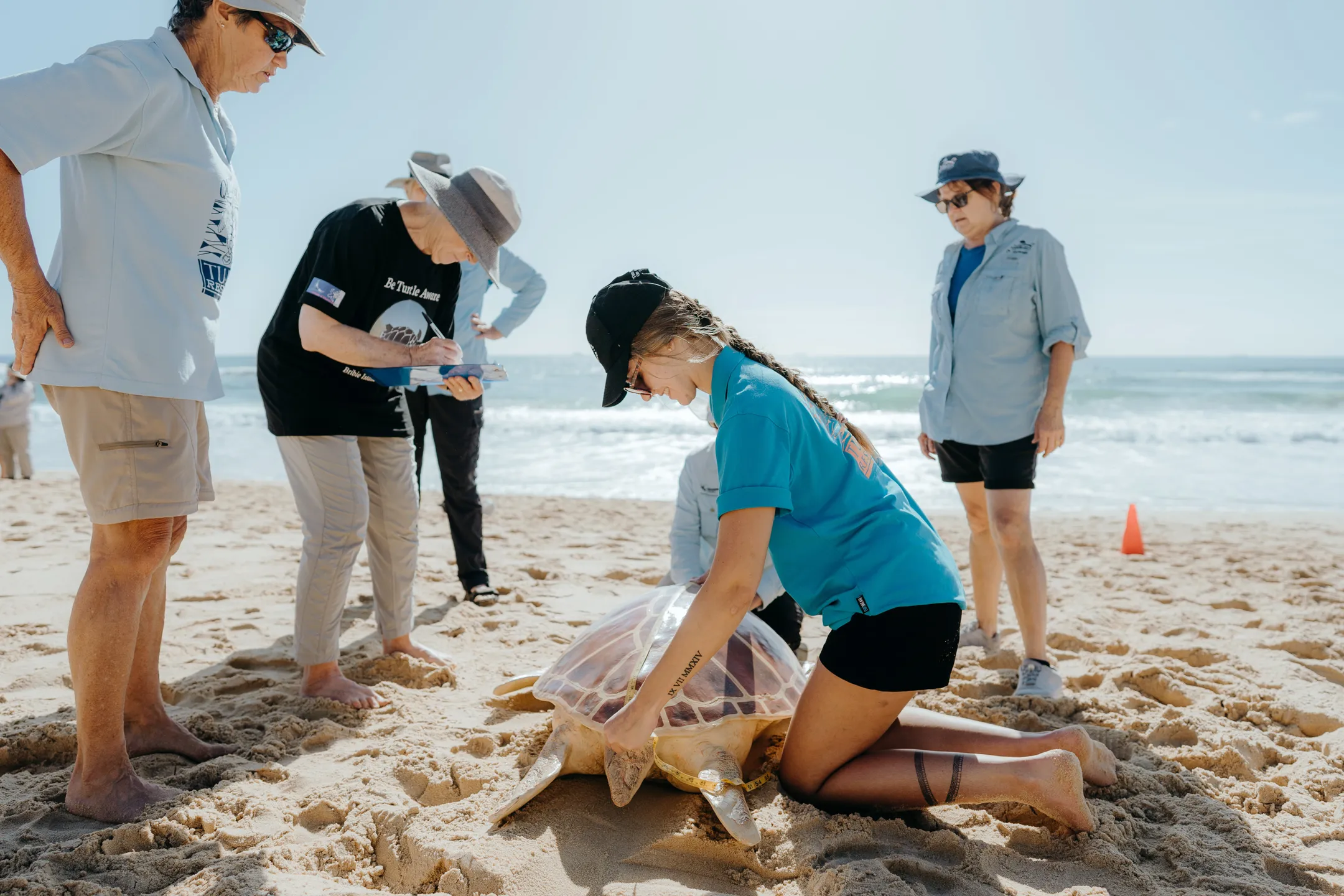Sunshine Coast marine turtle conservation plan
Find out how our Sunshine Coast marine turtle conservation plan will set us on the right track to help save one of our most beloved marine animals.

Making tracks together
The plan’s goal is to support the recovery of self-sustaining populations of marine turtles on the Sunshine Coast.
It will take steps to reduce threats to marine turtles, such as light pollution, and strengthen support of the dedicated community volunteer programs.
It focuses on nesting and hatchling success of the critically endangered loggerhead and vulnerable green turtle populations, the 2 species that arrive every year to lay their eggs on our Sunshine Coast beaches.
Our efforts to help these species recover will also have a flow on benefit for all other marine turtle species found in the coastal waters of the Sunshine Coast.
View the Sunshine Coast marine turtle conversation plan part A (PDF, 5.06MB) and part B (PDF, 2.93MB).
View the digital versions online - part A and part B (Flipbook).
Learn more about the plan and how we will do this
Vision
Vision
“Marine turtles surviving and thriving on the Sunshine Coast, co-existing in harmony with people.”
Primary goal
Primary goal
Supporting the recovery of self-sustaining populations of marine turtles on the Sunshine Coast by reducing threats, improving habitat quality, and strengthening community-based management.
Three themes to achieve our vision
Three themes to achieve our vision
To achieve our long-term vision and primary goal, this plan sets out desired outcomes and strategic directions under three overlapping and mutually supportive themes:
Theme 1. Strategic planning and policy guidance for turtle-sensitive lighting and coastal development.
Theme 2. Regional marine turtle recovery actions.
Theme 3. Sunshine Coast community based TurtleCare program delivery.
The plan identifies strategic directions and actions under each of these themes, to further strengthen the existing highly successful community-based volunteer TurtleCare program and associated citizen science activities.
These actions include strong education, awareness, and ongoing engagement with Kabi Kabi First Nation Peoples and the broader community, ensuring people and marine turtles co-exist in harmony on the Sunshine Coast.
The plan also proposes improved governance arrangements to coordinate ongoing implementation, evaluation, and improvement of the plan, in partnership with a range of stakeholders across the broader Sunshine Coast region.
All marine turtles found on the coast are depleted or severely depleted and subject to ongoing threats to the point that now every nest and every egg matter to population recovery, and direct management intervention will be increasingly required.
Greater levels of human intervention are likely to be required to achieve the nesting and hatchling success rates necessary for recovery of stocks found on the Sunshine Coast.
Therefore, an adaptive management approach has been identified as essential to allow appropriate response, ensure learning, and improve approaches from ongoing experience.
Desired outcomes for Theme 1
Desired outcomes for Theme 1
Theme 1 - Strategic planning and policy guidance for turtle-sensitive lighting and coastal development
By 2033 the desired outcomes (DO) are to have:
DO1. Strategic planning and policy guidance tools in place including:
(i) a regulatory framework for coastal development in the Sunshine Coast LGA that appropriately integrates State interests and the MTCP
(ii) educational guidance tools to support the development sector, property owners and residents to seek to achieve world best practice turtle sensitive development outcomes.
DO2. Development and implementation of lighting policies and standards that deliver a commitment to Dark Sky objectives and a naturally dark coastline at night, with minimisation of direct light sources and ambient light visible from sensitive nesting beaches and adjacent marine areas.
DO3. Nesting beaches identified as future climate refugia and protected as part of integrated coastal hazard management.
Desired outcomes for Theme 2
Desired outcomes for Theme 2
Theme 2 - Regional marine turtle recovery actions
By 2033 the desired outcomes (DO) are to have:
DO4. The identified threats (that are under the influence of the Sunshine Coast Council) reduced to lowest residual risk level to minimise negative impacts on nesting marine turtle populations.
DO5. Sufficient resilient essential habitat to support effective marine turtle nesting, foraging and courtship behaviour.
DO6. Maintain current male to female ratios on the Sunshine Coast to ensure continued recruitment of male turtles to the breeding population.
Desired outcomes for Theme 3
Desired outcomes for Theme 3
Theme 3 - Sunshine Coast community based TurtleCare program delivery
By 2033 the desired outcomes (DO) are to have:
DO7. The Sunshine Coast is recognised as a national and international leader in community-based marine and the TurtleCare program is fully integrated into Queensland and Australian strategies.
DO8. Secure, adequate funding for TurtleCare (and allied programs) allows optimal contribution to monitoring, managing, and recovering marine turtles in line with world best-practices.
DO9. Kabi Kabi First Nation Peoples are fully integrated into marine turtle management – the knowledge, culture and traditions, traditional rights, interests, management capacity and customary obligations are respected, strengthened, valued, and promoted.
DO10. A community of residents and visitors value marine turtles and are engaged in turtle conservation –community custodians/stewards.
Steps to get there
The implementation plan outlines the steps to accomplish the desired outcomes above. It:
- prioritises the activities
- identifies who is responsible for each activity
- sets the timing, any costs and other resources needed
- will be updated annually.
Background to the plan
A strong partnership across the region led to the plan’s development with Sunshine Coast Council, Councillors, Kabi Kabi First Nation Peoples, Queensland Government, an independent Technical Advisory Panel and community leaders of TurtleCare, Coolum and North Shore Coast Care and Bribie Island Turtle Trackers volunteers all collaborating on the plan.
It supports efforts by the Queensland and Australian governments to stop the decline of marine turtle populations and will guide council decision making to achieve future conservation and management goals for nesting marine turtles and hatchlings within the Sunshine Coast local government area.
It was endorsed at the August 2023 ordinary meeting of council.
